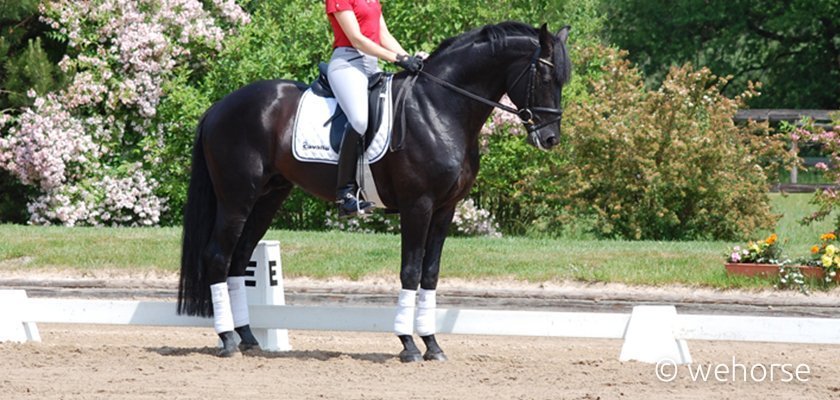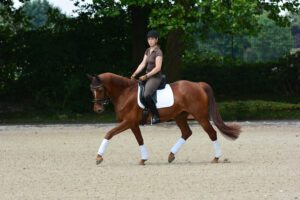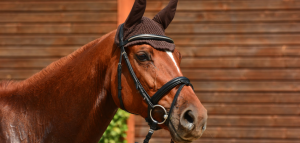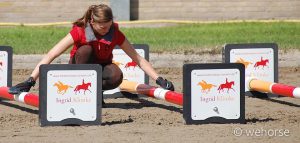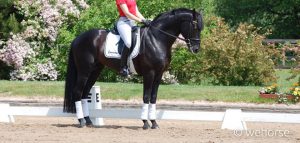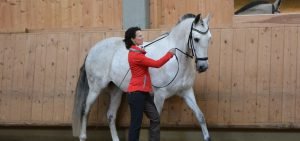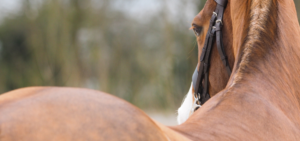There’s one thing that can help you collect extra points at your next dressage test: riding a good dressage halt! That’s because a good halt counts as much as other “more difficult” dressage skills. A proper halt leaves a good impression and will definitely rack up points. Dressage rider and trainer Benjamin Werndl talks about how he and his sister Jessica von Bredow-Werndl teach the concept of halting to young horses at their horse farm in Aubenhausen, Bavaria.
Summary
- Teaching a young horse to halt
- When to correct the horse
- Where should the halt be practiced
- Short or long reins?
- How long does it take to teach a horse to halt
- Never go backward as an important rule
- Correct halting in dressage tests
- The correct use of the rider’s aids
- Fine use of the hands
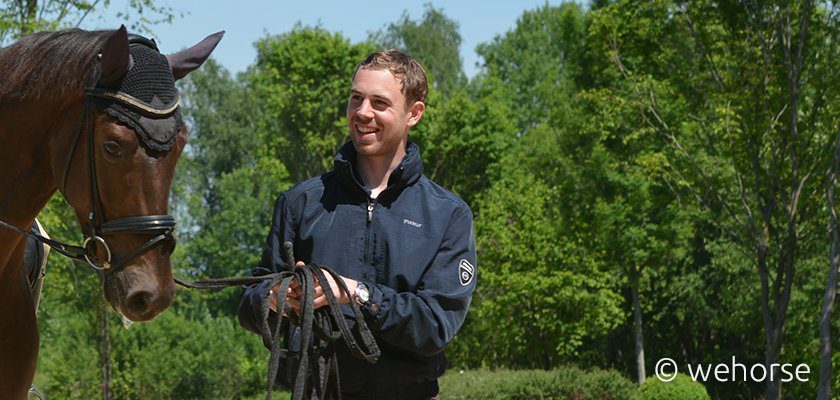
Teaching the young horse to halt
Dressage halts are practiced during the breaking-in phase, says Benjamin Werndl. The future dressage horses at Aubenhausen take their very first steps under a rider at the training stables of Warwick McLean. Here is where the young horses receive their basic training. Much work is done on desensitization and attaining suppleness. When the horses are broken in and are brought to the Werndls, one of the first things they are taught is to stand calmly.
Give correction or let it stand?
‘With young horses, it’s not so important in the beginning if they don’t stand square. First, they have to learn to stand still’, says Benjamin Werndl. ‘This is very important, especially for horses that are a little more easily spooked or impatient.’ A horse’s natural instinct is to run from danger, and this flight instinct makes halts a difficult skill for them to master. The Werndls often use voice aids in teaching the horses to stay still.
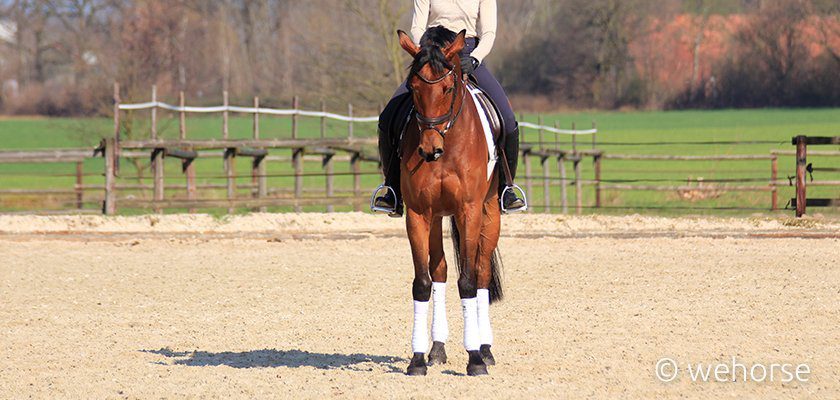
Where should you practice halting?
The Werndl siblings use a tactical strategy to make learning dressage halts easier. ‘For spooky horses that don’t relax easily, we practice halts in a calm environment, for example at the end of a training session.’ The horse should learn to associate dressage halts with a pleasant experience. ‘After getting on, I like to give him a little sugar. The horses quickly learn to remain still until they get sugar.’ For young horses it’s easier to have them stand at the wall than on the center line or the second track. When the horse learns to stand at the wall, Werndl will then leave the first track. ‘The wall is useful as a boundary element. I’ll move away from it later, and go to either the second track or the center line. The important thing is that I halt on a straight line.’
Short or long reins?
What kind of rein contact is used for halting with young horses? ‘I practice dressage halts with a yielded rein as well as with bit contact’, says Werndl. The goal is to use the rein as lightly as possible. Riding halts exclusively on loose or yielded reins doesn’t make any sense with young horses. ‘At dressage tests, during the halt and greet, I maintain a contact which I don’t want to lose. Therefore I also practice dressage halts on the bit very early!’
How long does it take to teach a horse to halt?
‘Usually, a horse will stand calmly after a couple of weeks’, says Werndl. Then comes the phase in which the horse receives correction and is instructed to stand correctly. ‘But I don’t want to upset them with constant correction. I take it easy with them. In the course of the year they’ll learn how to stand relaxed and square.’ Werndl says that one should practice less rather than more, especially with horses that tend to fidget. ‘I don’t keep such horses standing too long, as that just adds to the problem. Sometimes it’s better not to make too much of it, and then it will improve on its own.’ It’s hard to give general figures on how often or how long one should practice halting. ‘It’s like any other dressage lesson: twelve half passes are surely too many, and so are twelve halts. It should be good after just a few times.’
The more important rule is this: never go backwards!
The more important element in halting is that ‘a horse may move, but only forwards! He shouldn’t step back.’ A tendency to step backwards should be avoided at all times. ‘The horse should be in front of me even in a halt, that’s crucial! If he moves, then forward.’ He constrains the horse from the sides through his seat and legs; yielding sideways is undesirable.
Correct halting in dressage tests
What you want is for the horse to stand square, with both pairs of hooves – front and back – aligned, ‘although any deviation of up to a hoof’s width is acceptable’, says Werndl. The Werndls offer correction from two different perspectives: from the ground and from the saddle. ‘When I give a correction from the ground, I ask the horse to bring a hind leg further forwards by touching it with the whip.’ The same applies for bringing a front leg in line. Here, too, it is important that corrections always lead forwards; never send the horse backwards! The second method works like this: ‘In the saddle, I use my riding aids to let the horse move forward.’
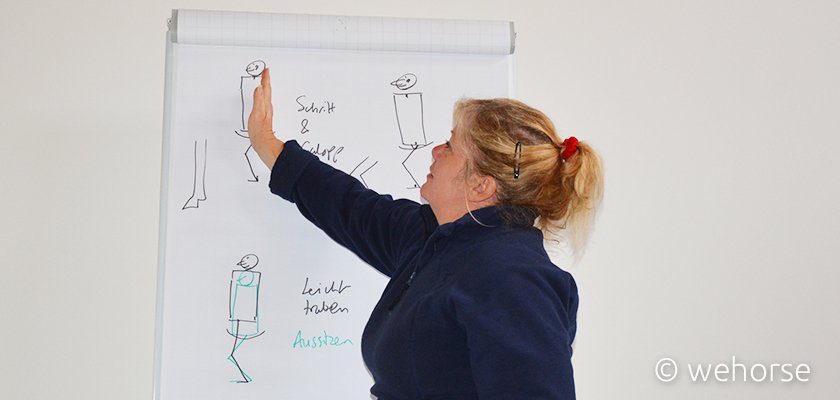
How to use the rider’s aids correctly for halting?
The British trainer Elaine Butler offers special courses in seat and balance. She teaches both leisure riders and dressage pros who compete internationally. The following concept is essential for giving the correct aid for halting, says Butler: ‘The brake is in your lower body and not in your hand!’ The lower back, the leg, consistent rein aids – most riders are theoretically knowledgeable of how to ride a dressage halt. There are a few tips, however, on improving your halt in practice. For example, the subject of weight aids. Elaine Butler has a good exercise for this. In order to give the correct aid, the rider must learn to control their own abdominal area and to slow their hip movement. Something that good riders do automatically. Elaine Butler’s suggestion for learning how to create this pressure below: ‘Press the middle of your tongue flat against the roof of your mouth. That’s how you activate your pelvic floor!’ This creates pressure in the lower body and the slowed pelvic motion tells the horse to slow down.
What about the hands?
Another problem some riders have with halting is doing too much with the hand. ‘This is hard for us humans, because of our instinct to grasp.’ If one sense that the horse is about to take another step before it halts, that’s the moment when you should slacken the rein, she says. ‘Otherwise a horse will move quickly against the bit and stop responding to you.’ The grasping instinct, moreover, is also paired with the instinct to lean back. ‘One often sees riders who lean backwards when they halt, with their elbows drawn in. But if you’re behind the vertical, you won’t be able to halt the horse very well!’ Butler offers an analogy: ‘Imagine that you’re skiing down a hill and you want to slow down. You wouldn’t lean back then, because that would make you go faster, not slower!’

